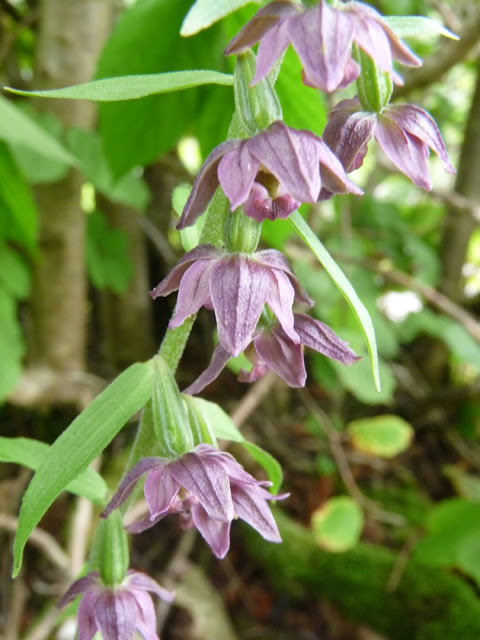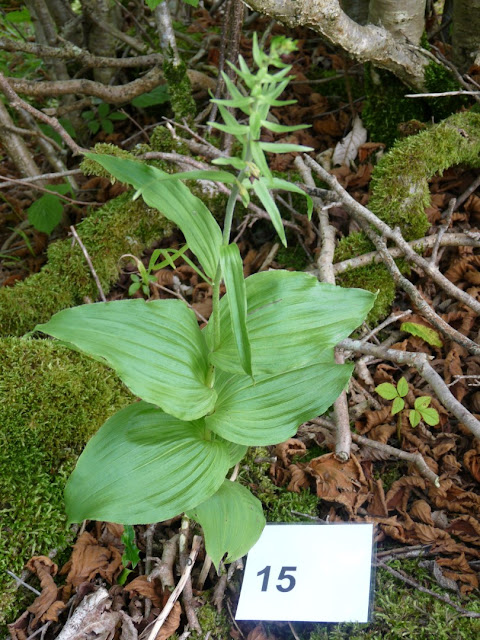Purpurea or Dark form No.1 (below)
Its probably gone on for years, yet it was about four years ago (2012) that I started to notice that certain small populations of E.helleborines were far more purple coloured than the norm, some so dense in colour just like the one above, although most were a lesser but more regular purple like the ones in the photos below. Also with purpurea I have noticed that the "very large" helleborine leaves also show a distinct darker tone against the norm which again probably indicates some sort of interference.
Another thing I did notice about these heavily purple coloured plants was that they all were recorded lying within canopy with plenty of shade and were generally on the fringes of copse or woodland, with occasional plants situated well into the canopy by anything up to 30 yards or so. There are two or three places in particular on the Hutton Roof Crags that can produce small populations of this "Purpurea" variety. One area in particular may have as many as 5 or 6 in a small area of say 10ft square. (see sketch below). Another interesting thing is that you dont always get purpurea next to purpurea, you may get a dark form right next to a light form although both are in the same "under canopy" areas, so obviously other factors may well be involved.
 |
| Photo of Purpurea or dark form No.1 - 4th August 2017 (Click over to enlarge) also see the flowers close up in the next photo |
 |
| Purpurea or Dark Form No.1 - 4th August 2017 (Click over to enlarge) |
 |
| Purpurea or Dark Form No.1 on 8th August 2017 (Click over to enlarge) |
 |
| Purpurea or Dark Form No.1 13th August 2017 (Click over to enlarge) |
 |
| Purpurea or Dark Form No.1 on 13th August 2017 |
Specimen No.3 Purpurea or dark form - I took this photo on 10th August 2016 (Click over photo to enlarge)
 |
| Purpurea or Dark Form No.3 - Photo taken 4th August 2017 (Click over to enlarge) |
 |
| Purpurea or dark form No.3 - Photo taken 4th August 2017 (Click over to enlarge) |
I guess all this is to do with photo-synthesis, and the area not getting enough direct sunlight must have something to do with it all. I do know this that it produces some fine looking specimens just like this one above which I took only last year (2017). This plant was not too far away from Specimen One (purpurea) which I showed earlier.
2018 Update (Purpurea or Dark Form No.3)
Checked it out at the correct times and there just was no show at all.
 |
| This is mid to dark and was taken in 2014 (Click over to enlarge) Purpurea SW 5 Purpurea SW5 on 31st July 2020 Purpurea SW5 on 31st July 2020 |
 |
| This is probably the "lightest" that I would qualify "Purpurea or dark form" from specimen 15 in 2012 (Click over to enlarge) |
 |
| This is a very nice plant (Specimen 15 purpurea or dark form) within a small population which is shown in the (See sketch below) - photo taken Aug 28th 2012 (Click over to enlarge) |
There is much variation in the amount of purple from plant to plant. They can look stunning especially with a contrast to green ovary bracts and stems just like the above sample.
The sketch further down shows the area were I first discovered specimen No.15 (Purpurea or dark form) see below - which was a stunning plant in 2012
 |
| Spec No 15 purpurea or dark form - photo taken in 2012 (Click over to enlarge) |
Its quite obvious from my photos that 2012 was a great year for the "purpurea", but this is not how it goes from year to year. If you check out the following photo (below) you will see the same plant (Spec No. 15 purpurea) the following year (2013) which has come through a little stunted in height to previous years, but more noticeable was that the buds of the flower actually died off and "aborted" long before coming through has a flower. All you actually saw was a sort of brown burnt out bud (you can see this in the photo) and you were eventually left with a bare plant with no flowers.
2021 was just a average year for purpurea or dark forms but here below is a sampling of some of the stars:
Photos below from 2013 - showing plant with just bracts and burnt out seeds
Specimen No. Purpurea or Dark Form No. 15 in 2013
Specimen Purpurea or dark form No. 15 in 2013
You will see from the sketch below that we did have five plants which came through showing this abortive state (in 2013), whilst others in the same collective came through as normal. Yet all the same flowers showed exceptionally well in the previous year (2012)
 |
| This is a sketch I did in 2013 showing the population but lots of aborted flowers (Click over to enlarge) |
2018 Update (Specimen Purpurea or Dark Form No.15)
Although the plant did show it was poor with stunted growth - the plant in question has been poor ever since the "stunted" appearance back in 2013, although one or two of its neighbouring specimens to its West side have come through OK and these plants have a sort of "ruby red" appearance.
In 2016 I had another plant of this species which also produced something similiar (see below). It was far away from the above population and also a isolated case. Again on the edge of a copse, I found this small stunted plant again with evidence of burnt out abortive buds. Also this specimen showed to be stunted in its growth especially towards the plume area with bracts squashing down on one another. The photos below show you how the plants came through.
****




















